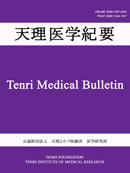Volume 13, Issue 1
Displaying 1-11 of 11 articles from this issue
- |<
- <
- 1
- >
- >|
Special Article
-
Article type: Special Article
2010 Volume 13 Issue 1 Pages 1-26
Published: December 25, 2010
Released on J-STAGE: April 08, 2022
Download PDF (29941K)
Original Article
-
Article type: Original Article
2010 Volume 13 Issue 1 Pages 27-38
Published: December 25, 2010
Released on J-STAGE: April 08, 2022
Download PDF (13381K) -
Article type: Original Article
2010 Volume 13 Issue 1 Pages 39-47
Published: December 25, 2010
Released on J-STAGE: April 08, 2022
Download PDF (534K) -
Article type: Original Article
2010 Volume 13 Issue 1 Pages 48-54
Published: November 25, 2010
Released on J-STAGE: April 08, 2022
Download PDF (428K) -
Article type: Original Article
2010 Volume 13 Issue 1 Pages 55-62
Published: December 25, 2010
Released on J-STAGE: April 08, 2022
Download PDF (1454K)
Case Report
-
Article type: Case Report
2010 Volume 13 Issue 1 Pages 63-70
Published: December 25, 2010
Released on J-STAGE: April 08, 2022
Download PDF (1413K) -
Article type: Case Report
2010 Volume 13 Issue 1 Pages 71-77
Published: December 25, 2010
Released on J-STAGE: April 08, 2022
Download PDF (387K)
Proposal
-
2010 Volume 13 Issue 1 Pages 78-87
Published: December 25, 2010
Released on J-STAGE: April 08, 2022
Download PDF (612K)
Commentary
-
Article type: Commentary
2010 Volume 13 Issue 1 Pages 88-104
Published: December 25, 2010
Released on J-STAGE: April 08, 2022
Download PDF (3633K)
Featured Papers of Departments (2009)
-
2010 Volume 13 Issue 1 Pages 105-121
Published: December 25, 2010
Released on J-STAGE: April 08, 2022
Download PDF (764K)
2009 Symposium Organized by Tenri Institute of Medical Research
-
2010 Volume 13 Issue 1 Pages 122
Published: December 25, 2010
Released on J-STAGE: April 08, 2022
Download PDF (467K)
- |<
- <
- 1
- >
- >|
